Declaration of the Lisieux Pilgrims
In numbers twice as large as last year, 3,200 French traditional Catholics gathered at the Basilica of St. Therese of Lisieux (Oct. 14, 2000) in Normandy to redeclare their appeal that theLatin Mass be fully restored to the Catholic Church and her priests.
His Excellency F. Baldelli
Apostolic Nunciature
10 avenue du President Wilson
75116 Paris
Your Excellency:
The Pilgrims of Catholic Tradition gathered once again at the Basilica of Lisieux on October 14, 2000. They were more numerous than in preceding years, and the Basilica was packed by some 3,200 strong. They came to gain the plenary indulgence of the Jubilee Year, as well as to express their reasonable desire and pastoral preference for the Latin Mass.
To this end, they organized themselves as a group, the Lisieux Pilgrims. At the end of the Holy Mass celebrated outdoors in the courtyard, with the permission of Msgr. Pican and the Basilica's Rector, they issued this declaration, or manifesto, which they herewith have the honor of addressing to Your Excellency. They also summarized in four points the demands, which summary is also attached herewith.
They hope to be recieved at the Nunciature by Your Excellency, so that they may defend the soundness of their resolutions. They assure you, Your Excellency, of their deepest respect....
The Declaration
We are united at last at Lisieux. We would not have missed this rendezvous of Catholic Tradition for anything in the world. We are at Lisieux to defend the Tridentine Mass and to obtain its free, unconditional celebration in all the churches of France and Navarre and the whole world. We confide this intention to our national patron saint, St. Theresa. We are at Lisieux before the Basilica, our hearts joyful, as loving sons of the Church, to make known to the ecclesiastical authority, gently yet firmly, our resolve not to let ourselves be despoiled of this good. We will never yield.
The recent words of Cardinal Stickler on this subject encourage us:
To summarize our thoughts, we can say that the theological benefits of the Tridentine Mass correspond to the theological deficiencies of the Mass issuing from Vatican II. For this reason, the "faithful of Christ" of theological Tradition must continue, albeit in a spirit of obedience to their legitimate superiors, to make known their reasonable desire and their pastoral preference for the Tridentine Mass.1
We are at Lisieux to say so, and to make it known to the Pope by the intermediary of the Nunciature to which we are forwarding this declaration.
We admit that we do not understand very well the reasons for this liturgical war, for this implacable opposition to the "Tridentine" Mass, to this immemorial liturgical custom which sanctified so many generations. Nevertheless, we recognize very well that a war is being waged, and we see very well the relentlessness of certain members of the current hierarchy against this Mass. The recent history of the Priestly Fraternity of St. Peter is still fresh in everyone's memory to confirm it.
We are at Lisieux to express once again our reasonable desire for the Tridentine Mass. And we shall return here each year at mid-October, coming more and more numerous, to manifest the same desire until victory.
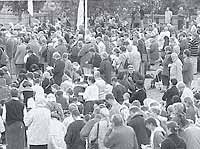 |
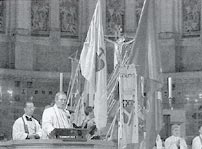 |
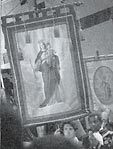 |
The clergy and the faithful enter the Basilica of Lisieux.
Fr. Tanouarn leads the chant from the Basilica's pulpit
with confrere Fr. Rousseau just behind him.
Lessons from the History of Heresy: A Ten-Point Comparison
We know, as history teaches us, that in the 16th century a Luther, a Calvin, had the will, even then, to destroy this Mass, to see it disappear, to make it disappear, even to corrupt it. We know that in this will is to be seen what Dom Gueranger in his Liturgical Institutions called the anti-liturgical heresy. Today we find the same stubborn intention, the same will, the same itch for novelty.
That is why we are here at Lisieux to pronounce our "non possumus." The Roman liturgy–the real one–is something in the Church far too excellent for the faithful not to rally joyously to its defense when it is so bitterly attacked by the heretic.
1) Yesterday, Protestants and Anglicans manifested a genuine hatred of Tradition as it is formulated in divine worship. They substituted new books and new formulas for the ancient books and the ancient formulas. That is how they would proceed.
Today, in this liturgical war, we behold the same spectacle; and we find that they have imposed a Novus Ordo Missae that aims in practice if not at law to banish the ancient books, the Roman Canon, and the ancient formulas.
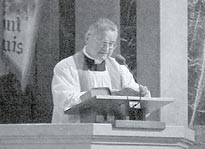
Fr. Paul Aulagnier, Second Assistant to the Superior General of the Society of Saint Pius X,
reads the Profession of Faith with the pilgrims.
2) Yesterday, where hatred of Tradition was present, we saw the heresiarch "fabricate" new liturgical formulas in place of the Roman canon of the immemorial Roman missal.
Today, Cardinal Ratzinger himself laments over this new liturgy which he asserts has been artificially concocted. In place of the liturgy, fruit of a continuous development, they have put a fabricated liturgy. They have departed from the living process of growth and of becoming into the realm of fabrication. They did not want to continue the organic development and maturation of something living throughout centuries, and have replaced them–on the model of technological production [he could have written, Protestant]–by a fabrication, the banal product of the moment.2
3) Yesterday, Protestants and Anglicans justified these liturgical fabrications–this Novus Ordo–by claiming the rights of antiquity. They wanted, so they said, to disentangle Christianity from all that error and human passion could have introduced of things false and unworthy of God. They only wanted the primitive elements and claimed to be resuming, from the cradle, the Christian institution.
Today, we observe the same spirit at work. We have seen the stubbornness with which some sought to impose on priests the use of the new canon, the Second Canon, which everyone now calls the Canon of St. Hippolytus, for the sole reason that it is very ancient.
4) Yesterday, the Protestants and Anglicans eliminated from worship all the ceremonies and formulas that expressed the mystery. All of that was, they said, but superstition and idolatry. So, no more sacraments but baptism; no more sacramentals nor benediction; no more images nor relics of saints.
Today, we often find in our own parish churches the coldness of the Protestant temple. This caused Cardinal Stickler to say:
The reform that followed Vatican II destroyed or changed the richness of numerous liturgical symbols. Yet the Council of Trent had highlighted the importance of this symbolism. Even a prominent atheist psychoanalyst deplored this fact, calling the Vatican Council II the Council of Accountants.3
5) Yesterday, there was no more altar, but only a table; no more sacrifice, but only a supper; no more church, but only a temple. Already religious architecture was no more, because there was no more mystery; Christian painting was no more, because religion was not for the whole man; poetry in worship was no more, because Love and Charity no longer informed it.
Today, it is with sadness that we behold our new churches: the Cathedral of Evry, the new Basilica of Lourdes. What barrenness! What banality! These are structures that are anything but churches, anything but places where is celebrated "the mystery of piety" (St. Paul).
We no longer hear them speak of the sacrifice of the Mass. That vocabulary is no longer in style. But on the contrary, we hear talk–as in the time of the Protestant Revolt–of supper, eucharist, Sunday services, the Lord's supper. The words have their importance; they convey a doctrine.
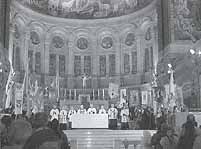
Priests of the Society, though not given permission to celebrate the Latin Mass in the Basilica, take over its sanctuary to bless the pilgrims.
6) Yesterday, the complete extinction of the spirit of prayer in Protestant circles occurred, that spirit of prayer which in Catholicism used to be called unction.
Today, where is that unction? Where can you find that liturgical charm that was the joy of the people, of the poor?
Msgr. Gamber, a master in liturgical matters, himself observes the loss of this spirit, and observes the return to Protestant austerity.
The element of worship (in the liturgy) is becoming less and less among us. In like manner, we have lost to a large degree the solemnity that is an element of every liturgical action. In every place one often sees reign a Calvinist austerity.4
7) Yesterday, they systematically called for the use of the vernacular language in divine worship. The point was capital. Worship no longer being the secret, mysterious thing, it was necessary for the people to hear what the priest chanted. Yes, the hatred of the Latin language is innate to the hearts of all the enemies of Rome.
And Today, we see nothing different on the matter. The disappearance of Latin is total, even in the Eternal City and the Roman basilicas. Yet the Second Vatican Council did not will it so.
8) Yesterday, the liturgy had to be celebrated aloud. Silence was banished, and recollection, too.
And Today, it is Cardinal Ratzinger himself who pleads in favor of silence in the liturgy:
To the great displeasure of many liturgists, I declared in 1978 that the Canon should never be recited aloud in its entirety. After mature reflexion, I would like to reiterate it here, expressly, in hope that twenty years from now, this affirmation will be accorded greater understanding....It is now manifest that it is useless to multiply words....It is absolutely false to pretend that the complete and uninterrupted reading aloud of the Canon is needed for the participation of all in this central act of the Eucharistic celebration....Someone who knows by experience what is a community united in the Canon recited in a low voice, knows truly what is meaningful silence, and at the same time an engaging and strong appeal addressed to God, an authentically spiritual prayer.5
We benefit perfectly from this silence in the celebration of the Tridentine Mass. That is why we are happy to unite with the Cardinal in this defense of liturgical silence.
9) Yesterday, in the Protestant temple there was also celebration facing the people.
Today, this practice is universal in the Catholic Church, and our Cardinal deplores it, and wants to react against it. In his recent book on this subject, The Spirit of the Liturgy, he writes:
In Christian antiquity, no one would have had the idea of placing the president of a meal facing the people. On the contrary, the social character of the meal was heightened by the disposition of the guests who were all placed on the same side of the table. In this analysis of the "form of the meal," it is fitting, moreover, to add that it is totally inadmissible to qualify the Eucharist of the Christians as a simple "meal." Undoubtedly, the Lord founded the novelty of Christian worship in the framework of a Jewish meal (that of the Passover), but it is this "novelty" that He commanded His disciples to renew, and not the meal as such.
10) Yesterday, the priesthood was also suppressed, abolished. The reforms of Luther and of Calvin recognized only ministers, ministers of God or of men, as you will. And the minister is only a layman vested with accidental functions. In the name of the people united, he presides over the service.
Today, this is the very definition of priesthood given in the notorious Article 7 of the liturgical reform issued from Vatican II:
The Lord's Supper or Mass is the sacred assembly or meeting of the People of God, met together with a priest presiding to celebrate the Memorial of the Lord. For this reason the promise of Christ is particularly true of a local congregation of the Church: "Where two or three are gathered in my name, there I am in their midst" (Mt. 18:20).6
The Mass is no longer the specific act of the priest, the reason for his priesthood. The Mass is even more the work of the people. The Mass, according to Article 7, belongs only to the priest because he is part of the multitude. He merely presides, he merely fulfills a function. The facts of today prove the truth of this analysis. And now they talk to us about liturgical celebrations in the absence of a priest, as they talk, with a straight face, about absolution in the absence of a priest.7
We do not belong to that religion. We reject it, and we refuse to give it our support. We are here at Lisieux to say so.
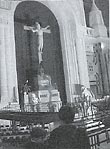 |
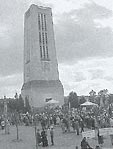 |
The pilgrims exit the Basilica to the Shrine's plaza for the Solemn High Latin Mass.
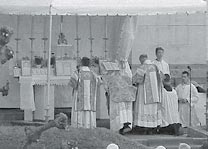 |
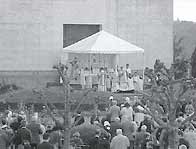 |
The tent at the base of the monument shelters the altar
while the one at right has been pitched for the choir.
Cardinals Agree
Yes, we declare that we are here at Lisieux in front of the Basilica to defend the Mass of all time, the Roman Mass. It protects our faith. It keeps us in the faith. It expresses the doctrine–lex orandi, lex credendi–that the Council of Trent formulated and fixed forever against Protestantism, the doctrine of the Sacrifice of the Cross. It expresses for us the doctrine of the Real Presence of our Lord Jesus Christ by the transubstantiation of bread into His body, and wine into His blood by the words of the consecration pronounced by the priest alone, accomplishing in the name of Christ (in persona Christi), not a narrative (narratio institutionis), but the very act of Christ offering Himself by His body, by His blood, a holy victim all to the glory and honor of His Father and to the advantage of the faithful living and dead, for the remission of sins. What a beautiful action! What a just action!
It is to this act that we love to unite ourselves every Sunday, and even more often when possible.
Yes, we are at Lisieux to defend this Mass, the Mass so-called of St. Pius V, the Tridentine Mass. We want this Mass without, however, excluding the other rites acknowledged within the Church, provided that they be truly Catholic! like the Lyonnaise rite, the Dominican rite, the Carthusian... In this matter, we are bi-ritualists–no, pluri-ritualists. Diversity is richness. The liturgical rites are multiple, the reality expressed is one and the same: the sacrifice of the Cross renewed.
But we refuse this new Ordo Missae which is called Roman, though it is not really, because it does not conform on all points to the theology of the Mass established definitively by the Council of Trent, the Roman Church.
We rejoice to be corroborated in this resolution both by Cardinal Ratzinger and by Cardinal Stickler. The latter quite recently made some very critical remarks about the liturgical reform of the Mass. He recognizes that, among other things, the new "offertory of the Mass constitutes a revolution."8
We do not want to take part in that revolution.
He recognizes that they have wiped the slate clean of "the signs highly praised by the Council of Trent and required by the Vatican Council II, such as the numerous signs of the cross which signify the Blessed Trinity, the kissing of the altar, and the genuflexions."9
We do not want to participate in that movement. Who can reproach us for that! We can give as a reference on our behalf Cardinal Stickler, Roman Cardinal. He recognizes that:
The essential center of the Mass was precisely the sacrificial action itself, and it was clearly displaced by the reception of Communion in the measure that the sacrifice of the Mass has been transformed into a Eucharistic meal. By doing this, if you consider the terms used, the Communion has become, in the minds of the faithful, the only part of the Mass that has a unifying effect, instead of and in place of the essential part, which is the sacrificial action of transubstantiation....Now, it is false to make of the Eucharist a meal, which is what almost always happens in the new liturgy.10
That is the statement of the Cardinal, who is denouncing the gravest danger threatening the Church's purity of faith.
As for us, we do not want to take part, especially by our presence, in this subversion of the faith. And we are encouraged by the Cardinal, a cardinal of the Roman Church. We should constantly remind ourselves of this fact.
The Cardinal deeply regrets "the very serious corruption of the formula of consecration of the wine into the blood of Christ. The words mysterium fidei (in the formula of consecration of the wine) have been suppressed and added to the call of the people to prayer."11 He laments this modification, for "the words mysterium fidei (in the formula of the consecration of the wine) come from the holy tradition which is the interpreter and the guardian of Catholic truth."12 He laments, "We receive this teaching, and we express our thanksgiving for these words."
The Cardinal equally observes that the participation of the faithful in the sacrificial action of the priest–good in itself, and which it is necessary to preserve–often degenerates into an "incessant stream of words and actions, such that the result is a kind of activism that results more from a purely exterior human gathering..." and this happens "just before the most sacred moment for the participants: in the individual meeting of each of the faithful with the God-Man in the host....The sacred must finally die out: thus what is merely human kills the divine, and fills the heart with emptiness and desolation." He develops his thought:
This moment (of Communion) belongs to the silence which is expressly called for, and which has kept its place, with great difficulty, only after the action of distributing the Communion, as a tiny grape leaf on a large bare body. It is thus that, reflecting on the current tendency of the world's conscience to limit itself to appearances, one can see developing in the Church a cultural action of purely human conception, projected entirely towards exterior things.13
As for us, we want no part of this process of "demystification" of the liturgical action, nor, inversely, of its "anthropomorphization," to use the terms employed by the Cardinal. Thus, we desire to be able to assist at the Roman Catholic Mass always and everywhere, in every place, freely; it is the Catholic Mass that keeps us from all these evils so recently decried. We refuse this newfangled rite which ends by causing grave danger to the purity of the faith.
Yes, we want the Mass, Catholic and Roman, and we refuse the new Ordo Missae despite its quasi universal acceptance by the hierarchy of the Roman Church.
However, on this subject, we want to call to mind the wonderful and courageous reactions of Cardinal Ottaviani, Cardinal Bacci, His Grace Archbishop Lefebvre, Bishop de Castor Meyer, numerous theologians of renown, such as the Reverend Fr. Calmel, Fr. Dulac, Dom Guillou; as well as the magnificent interventions by men of letters and science who were grouped around the review Itineraires and its director, Mr. Madiran. Nor do we forget the important interventions made at present by Cardinal Ratzinger, Cardinal Stickler, Cardinal Dannels, Msgr. Gamber, a liturgist of international repute.
They are not so many, it is true; rather, they constitute a few, a very few. But then, we remember that during the heresy of Arius, only a few bishops resisted: an Athanasius, a Hilary. It is they who today receive the honor of the altars; they are honored as doctors and confessors of the Faith. Courage is not always the lot of the many, not even in the ecclesiastical world.
We also remember a Fisher, a More. They were both first loved, then hated, repudiated, and finally sacrificed, executed. The others, all the others, their fathers–their confreres–were honored, the fear of the powerful having overwhelmed them. But it is now John Fisher who is on the altar, as is Sir Thomas More. They were right. They are our models...even though they're English!
Conclusion
We want the Roman Mass, we want it alone, and we refuse this bi-ritualism that Conciliar Rome has managed to impose on the Fraternity of St. Peter. We refuse this bi-ritualism that allows them to keep the old Mass–under certain conditions–all the while obliging them, from time to time, at least for the present, though tomorrow it may well be always, to celebrate the new Mass despite its striking departure from the Catholic theology of the Mass.
We refuse this kind of bi-ritualism because we know that it has been proposed only for a time, and that tomorrow, there will be no more bi-ritualism at all for those who will have accepted it, but only one rite, a mono-ritualism, the new rite of Paul VI.
Of that, we are absolutely sure. That is Rome's intention. That has been their constant aim. That is the thought that was quite clearly expressed by the Secretariat of State, by Msgr. Re and confirmed even more recently by Cardinal Medina on July 3, 1999: "The general law remains the usage of the rite renewed since the Council, while the usage of the anterior rite currently arises from privileges which must remain exceptional in character." The divers measures that they had to take over the years in favor of the ancient rite were taken solely in order to "facilitate the 'ecclesial' life of a certain number of the faithful, but never with the aim of perpetuating the anterior liturgical forms."14
"Never with the aim of perpetuating the anterior liturgical forms." This sentence is the key to their plan: the usage of the anterior liturgical forms is to be limited in duration.
This clause strikes us as proceeding from a mean spirit; from the doctrinal point of view, it strikes us as indefensible.
"The classical liturgy" of the Roman rite of the Mass is already endowed with an intrinsic perpetuity as an incomparable monument of the Faith. Its universal, centuries-old usage even prior to the Apostolic Constitution Quo Primum, confers on it, in addition, the canonical perpetuity of "consuetudo immemorabiliis." Consequently, the perpetuation spoken of by Msgr. Re and Cardinal Medina is not something to be granted or removed from the classical liturgy. It is something that must be simply recognized and respected by all.
Four-Point Summary of the Demands of the Lisieux Pilgrims
Here is the essential object of our action at Lisieux, which was meant to be, not parochial, but "ecclesial" in scope. Here is a summary of what we desire to communicate at the conclusion of our pilgrimage, and which we wish to make public:
1) That the traditional Ordo of the Roman liturgy be formally recognized as being an intrinsic part of the living tradition of the Church;
2) That this Ordo be recognized "as equal in law and in dignity" to all the other traditional rites of the Church legitimately recognized;
3) That, as the Church bound herself to do at the Second Vatican Council, "it be conserved in future and even favored in every way, and in no wise combatted"; and finally,
4) That it be affirmed that all the priests and faithful attached to this ancient rite enjoy all the liberties and all the faculties to celebrate it and assist at it.
We confide this action of the Lisieux pilgrims to the patronage of Saint Theresa.
(Signed) The Assembled Lisieux Pilgrims
1. "Testimony of an Expert at the Council," C.I.E.L., p. 22. Words addressed at Fort Lee, on May 20, 1995, to the members of the association Christi Fideles on the benefits of the Tridentine Mass.
2. From the preface to the book by Msgr. Gamber, La reforme liturgique en question, p. 8.
3. "Testimony of an Expert at the Council," p. 20.
4. Gamber, op. cit., p. 13.
5.Cardinal Ratzinger, Der geist der liturgie, p. 184.
6. Translation as cited in Michael Davies's Pope Paul's New Mass, p. 285 (available from Angelus Press).
7. Cf. Catholics, No. 68, p. 98: "Assemblees penitentielles en 1'absence de pretres"–Penitential services in the absence of priests.
8. Cf. "Testimony of an Expert at the Council," p. 40.
9. Ibid., p. 42.
11. Ibid., p. 44
12. Ibid., p. 46
13. Ibid.
14. Letter of January 17, 1994 to Mr. de Saventhem.
